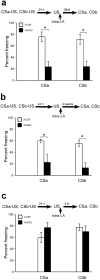The amygdala encodes specific sensory features of an aversive reinforcer
- PMID: 20348916
- PMCID: PMC2860669
- DOI: 10.1038/nn.2520
The amygdala encodes specific sensory features of an aversive reinforcer
Abstract
Studies of reconsolidation, in which retrieved memories are altered and restored, offer an approach for exploring the associative structure of fear memory. We found that exposure to the unconditioned stimulus initiates an unconditioned stimulus-specific reconsolidation of learned fear in rats that depended on the amygdala. Thus, specific features of the unconditioned stimulus appear to be encoded in the amygdala as part of fear memories stored there.
Figures


Similar articles
-
The selectivity of aversive memory reconsolidation and extinction processes depends on the initial encoding of the Pavlovian association.Learn Mem. 2013 Nov 19;20(12):695-9. doi: 10.1101/lm.031609.113. Learn Mem. 2013. PMID: 24255099 Free PMC article.
-
NMDA receptors are critical for unleashing consolidated auditory fear memories.Nat Neurosci. 2006 Oct;9(10):1237-9. doi: 10.1038/nn1778. Epub 2006 Sep 24. Nat Neurosci. 2006. PMID: 16998481
-
Synapse-specific reconsolidation of distinct fear memories in the lateral amygdala.Nat Neurosci. 2007 Apr;10(4):414-6. doi: 10.1038/nn1871. Epub 2007 Mar 11. Nat Neurosci. 2007. PMID: 17351634
-
What the amygdala does and doesn't do in aversive learning.Learn Mem. 2003 Sep-Oct;10(5):306-8. doi: 10.1101/lm.68403. Learn Mem. 2003. PMID: 14557601 Review. No abstract available.
-
The Neural Foundations of Reaction and Action in Aversive Motivation.Curr Top Behav Neurosci. 2016;27:171-95. doi: 10.1007/7854_2015_401. Curr Top Behav Neurosci. 2016. PMID: 26643998 Review.
Cited by
-
Acid-sensing ion channel 1a regulates the specificity of reconsolidation of conditioned threat responses.JCI Insight. 2022 Feb 22;7(4):e155341. doi: 10.1172/jci.insight.155341. JCI Insight. 2022. PMID: 35025766 Free PMC article.
-
Comprehensive neurocognitive endophenotyping strategies for mouse models of genetic disorders.Prog Neurobiol. 2012 Feb;96(2):220-41. doi: 10.1016/j.pneurobio.2011.12.001. Epub 2012 Jan 13. Prog Neurobiol. 2012. PMID: 22266125 Free PMC article. Review.
-
Emotional dysfunction as a marker of bipolar disorders.Front Biosci (Elite Ed). 2012 Jun 1;4(7):2622-30. doi: 10.2741/e578. Front Biosci (Elite Ed). 2012. PMID: 22652673 Free PMC article. Review.
-
Stress within a restricted time window selectively affects the persistence of long-term memory.PLoS One. 2013;8(3):e59075. doi: 10.1371/journal.pone.0059075. Epub 2013 Mar 27. PLoS One. 2013. PMID: 23544051 Free PMC article.
-
Intergenerational transmission of emotional trauma through amygdala-dependent mother-to-infant transfer of specific fear.Proc Natl Acad Sci U S A. 2014 Aug 19;111(33):12222-7. doi: 10.1073/pnas.1316740111. Epub 2014 Jul 28. Proc Natl Acad Sci U S A. 2014. PMID: 25071168 Free PMC article.
References
-
- Sara SJ. Learn. Mem. 2000;7:73–84. - PubMed
-
- Nader K, Schafe GE, Le Doux JE. Nature. 2000;406:722–726. - PubMed
-
- Tronson NC, Taylor JR. Nat. Rev. Neurosci. 2007;8:262–275. - PubMed
-
- LeDoux JE. Annu. Rev. Neurosci. 2000;23:155–184. - PubMed
-
- Fanselow MS, Poulos AM. Annu. Rev. Psychol. 2005;56:207–234. - PubMed
Publication types
MeSH terms
Substances
Grants and funding
LinkOut - more resources
Full Text Sources
Other Literature Sources

